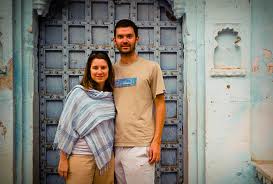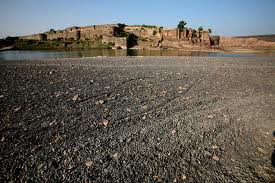Villages to Visit in
Rural Rajasthan
|
|
|
|
|
|
|
|
There are many villages in Rajasthan which can be visited. Some of
these villages are located in the Shekhawati region, around
Jaisalmer, Udaipur and Bikaner. The villages of Rajasthan are a
classic way of exploring the arduous life of Rajasthani folks who
lives on the stubborn pulse of nature. These people live happily on
the rugged terrains and enjoy a unique lifestyle that surely adds
colour to the village lifestyle. Wrinkled tree thickets, beautifully
painted kitchen walls, drooping camels chewing light green fodder
lazily is what gives Rajasthani villages an extra edge for rural
tourism. Come and experience a lifestyle still untouched by the
hands of modernity. If you want to experience the true essence of
Rajasthani village life and that too from a close quarter, then you
can stay in the rugged huts of the village people. You can also
enjoy the delicious village cuisine, served hot from the rugged
kitchen of the household. Enjoy your meals with chunks of fresh
butter and 'lassi' (buttermilk) that adds a superb taste to the
rural meals. |
 |
|
|
|
Nathdwara |
|
Nathdwara,
a small village town is situated about 48 km north of Udaipur. It
houses the most sacred shrine of Vaishnavites build in the 18th
century. Inside the temple of faith there you can see a black stone
Vishnu image, that was brought here from Mathura in 1669 to protect
it from the Aurangzeb demolition. The devotes treat the image like a
dainty child, wake him up in the morning, washing it, putting his
cloths on, offering it special meals and prayers, and putting it
down to a sleep. Thousands of pilgrims visit this shrine during
Diwali, Holi and Janmashtami. Nathdawara is also famous for its
Pichwai Painting, which was practiced after the Vishu image was
brought here. These bright paintings, with their rather static
images were usually done with the hand-spun-fabrics. The village
peoples fabricate these paintings since generation and now the
Pichwai paintings have turned into a lucrative trade business.
Another attraction of the town is Shrinatji Temple. Hundreds of
devotes throng to seek the special blessings of Shrinathji (Lord
Vishnu). The special arrangements are made for pilgrims to catch the
glimpse of Shrinathji, for which the doors open eight times a day.
Rest of the day the temple seems to be crowd free. The interiors of
the temple are impressive enough to reflect the real Rajasthani
style. Some of the ornaments of Lord Vishnu belong to Mughal India.
The antique silver and gold jewellery is embellished over the statue
of Shrinathji. The temple door is decorated with drawings of
elephant, horses and beautiful maidens. Temple servants still wore
those old costumes that belong to bygone era, the pankhwalas still
run those big fans manually so as to keep the interior cool, the
formal prayers are offered with diya (lighted earthen pots), flowers and
fruits. From Nathdwara, you can also buy the crafted idols of gods
and goddess in terracotta, stone and metal, Enameled and silver
jewellery, wooden toys, cloth lanterns, colorful puppets, terracotta
crafts, handmade paper crafts.
|
|
|
|
Kumbhalgarh |
|
Kumbhalgarh is known as one of the old village, where basically two
communities resided in its olden days. Kumbhalgarh is famous for its
colossal fort located 84 km north of Udaipur. The Kumbhalgarh Fort
is an important landmark of Mewar after Chittorgarh. The fort was
originally build by Maharana Khumbha in 15 century to protect Royal
Rajputana in the time of danger. The Kumbhalgarh remained
unconquered due to its 1100 m high location on the hill top of
Aravalli ranges. The fort has thick wall stretches of about 36 km
that made it a dream for its rivals to conquer this periphery. The
fort also houses an ancient temple, palaces, gardens, water storage
facilities and big courtyards that make it again a self-sufficient
dwelling. The mesmerizing beauty of fort depicts the influence of
Mughal, British and Rajasthani architecture. However as you forward
your foot to reach for the door ways, there you can see miniature
paintings of wildlife and carved motifs that displays the true
mughal learnings. Here the tourist can also explore the excellent
camel safaris on the sand dunes, rural lifestyle
of Rajasthani villages and the wild life sanctuaries in the walking
distance of the village. |

|
|
|
|
|
|
Ranakpur |
|
Ranakpur
is a village which is situated near Sadri town in Pali district of
Rajasthan, about 48 km from Kumbhalgarh and 90 km from Udaipur.
Ranakpur is known for most beautiful and biggest Jain Temples in
India. These ancient temples houses the statue of Mahavira and other
Jain saint. The main temple is Chaumukha Temple also known as Four
Faced Temple, build in 1439 with superbly crafted and well kept
marbles. This temple is dedicated to Adinath, the first Trithankar.
The 29 halls are supported by 1444 pillars inside the temple
premises. Within the complex there are two more Jain Temples of
Neminath and Parasnath. Sun Temple and Amba Mata Temple are also
located not far from the complex. The villages are well painted with
the sketches of peacocks, elephants, horses
and human figures. The tourists can walk through the village and can
experience the villagers lifestyle. The colourful lifestyles of the
people of Ranakpur is depicted by most of the Jain followers in the
village. |
|
|
|
|
|
|
Ghanerao |
|
|
Ghanerao is a small village that is situated in the district of
Pali in Rajasthan, about 18 km from Ranakpur. This royal village was
built in the 15th century. It is a major center of attraction for
tourists due to the Ghanerao Royal Castle. Beside this, the Ghanerao
also houses the castle of great worshipper Meera Bai, a poetess and
a great devotee of Lord Krishana. It is considered to be the
childhood town of Meera Bai, where she worshipped Lord Krishna
throughout her life. The Ghanerao Royal Castle is build up of
sandstone and is now converted into a heritage hotel. The highlight
of this castle is the pavilion in the central court. Near the castle
there are cenotaphs of former legends, Jain Temple and the Mahavir
Temple.
|

|
|
|
|
Bambora |
Bambora is major trek for various tourists. Bambora is located
nearly 45 km in the south east of Udaipur. This small village has a
250 year old fort that has been now converted into the heritage
hotel. The Bambora fort offers you a peaceful stay in rural
Rajasthan. It is the fort of great martyrdom, where various battles
were fought over a period of time.
|
|
Jaisamand |
|
The
Jaisamand Lake is one of the largest artificial lake in Asia,
covering an area of 36 square km. This lake was constructed by
Maharana Jai Singh in the 1685 A.D., fortunately created by damming
of Gomti River. This shallow lake is located nearly 48 km in the
southeast of Udaipur. Today it is considered to be 14 km long and 9
km wide. It is the most tourist populated spot during summers.
Beside this there are number of attractive marble chhatris
(cenotaphs) around the lakeside, each of them with an elephant in
the front. The summer palace of Maharani of Udaipur is located near
the Jaisamand Lake which provided refreshing moods to the women of
Royal Rajathan in its olden days. Around the lake, there is long
forest zone that was once the hunting grounds of Maharanas of Mewar.
It is now converted into a sanctuary which has wide verity of flora
and fauna. There are about seven islands on Jaisamand Lake. The
nearby area and the low
lake site are inhabited by the tribes of Bhils and Minas. |
|
|
|
Jhalawar |
|
Jhalawar was the princely state of the Jhalas. Jhalawar was created
in 1838 A.D., after being separated from Kota by the British.
Jhalawar is sitauted in the south-eastern region of Rajasthan at the
edge of the Malwa plateau. Jhalawar has rocky and water-laden
verdant landscape. With some exquisite pre-historic cave paintings,
massive forts, thickly wooded forests and exotic wildlife variety,
Jhalawar boasts of rich historic as well as natural wealth. The main
attractions of this place are the Jhakawar Fort, Government museum,
Bhawani Natya Shala and the Buddhist caves. The ancient Buddhist
caves of Kolvi, Vinayaka and Hathyagod are situated in the
Bhawanimandi in Jhalawar in the form of a triangle at a distance of
about 6 to 8 kms. from each other. A colossal figure of Buddha and
the carved stupas are the most impressive structures in the caves.
Certain unique trees were found near the monasteries and caves in
the Buddhist times. The nearest railway station to reach the caves
is from Bhawanimandi. |

|
|
|
|
|
www.indovacations.com
Copyright © Indo Vacations team.
All Rights Reserved. |